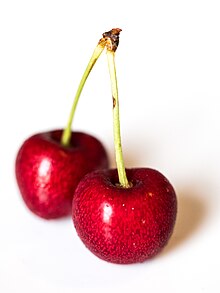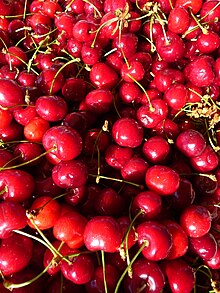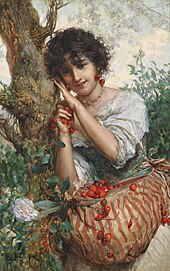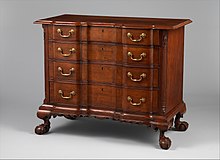Cherry


Acherryis thefruitof many plants of the genusPrunus,and is a fleshydrupe(stone fruit).
Commercial cherries are obtained fromcultivarsof several species, such as the sweetPrunus aviumand the sourPrunus cerasus.The name 'cherry' also refers to the cherry tree and its wood, and is sometimes applied toalmondsand visually similar flowering trees in the genusPrunus,as in "ornamentalcherry "or"cherry blossom."Wild cherrymay refer to any of the cherry species growing outside cultivation, althoughPrunus aviumis often referred to specifically by the name "wild cherry" in the British Isles.
Botany
True cherries


Prunussubg.Cerasuscontains species that are typically called cherries. They are known as true cherries[1]and distinguished by having a single winter bud peraxil,by having theflowersin smallcorymbsorumbelsof several together (occasionally solitary, e.g.P. serrula;some species with shortracemes,e.g.P. maacki), and by having smooth fruit with no obvious groove.[2]Examples of true cherries are:
- Prunus apetala(Siebold & Zucc.) Franch. & Sav. – clove cherry
- Prunus avium(L.) L. – sweet cherry, wild cherry, mazzard or gean
- Prunus campanulataMaxim. – Taiwan cherry, Formosan cherry or bell-flowered cherry
- Prunus canescensBois. – grey-leaf cherry
- Prunus cerasusL. – sour cherry
- Prunus emarginata(Douglas ex Hook.) Walp. – Oregon cherry or bitter cherry
- Prunus fruticosaPall. – European dwarf cherry, dwarf cherry, Mongolian cherry or steppe cherry
- Prunus incisaThunb. – Fuji cherry
- Prunus jamasakuraSiebold ex Koidz. – Japanese mountain cherry or Japanese hill cherry
- Prunus leveilleana(Koidz.) Koehne – Korean mountain cherry
- Prunus maackiiRupr. – Manchurian cherry or Amur chokecherry
- Prunus mahalebL. – Saint Lucie cherry, rock cherry, perfumed cherry or mahaleb cherry
- Prunus maximowicziiRupr. – Miyama cherry or Korean cherry
- Prunus nipponicaMatsum. – Takane cherry, peak cherry or Japanese alpine cherry
- Prunus pensylvanicaL.f. – pin cherry, fire cherry, or wild red cherry
- Prunus pseudocerasusLindl. – Chinese sour cherry or Chinese cherry
- Prunus rufaWall ex Hook.f. – Himalayan cherry
- Prunus rufoidesC.K.Schneid. – tailed-leaf cherry
- Prunus sargentiiRehder – northern Japanese hill cherry, northern Japanese mountain cherry or Sargent's cherry
- Prunus serrulaFranch. – paperbark cherry, birch bark cherry or Tibetan cherry
- Prunus serrulataLindl. – Japanese cherry, hill cherry, Oriental cherry or East Asian cherry
- Prunus speciosa(Koidz.) Ingram – Oshima cherry
- Prunus takesimensisNakai – Ulleungdo cherry
- Prunus yedoensisMatsum. – Yoshino cherry or Tokyo cherry
Bush cherries

Bush cherries are characterized by having three winter buds per axil.[2]They used to be included inPrunussubg.Cerasus,but phylogenetic research indicates they should be a section ofPrunussubg.Prunus.[1]Examples of bush cherries are:
- Prunus cistenaKoehne – purple-leaf sand cherry
- Prunus humilisBunge – Chinese plum-cherry or humble bush cherry
- Prunus japonicaThunb. – Korean cherry
- Prunus prostrataLabill. – mountain cherry, rock cherry, spreading cherry or prostrate cherry
- Prunus pumilaL. – sand cherry
- Prunus tomentosaThunb. – Nanking cherry, Manchu cherry, downy cherry, Shanghai cherry, Ando cherry, mountain cherry, Chinese dwarf cherry, Chinese bush cherry
Bird cherries, cherry laurels, and other racemose cherries


Prunussubg.Paduscontains most racemose species that are called cherries which used to be included in the generaPadus(bird cherries),Laurocerasus(cherry laurels),Pygeum(tropical species such as African cherry) andMaddenia.[1]Examples of the racemose cherries are:
- Prunus africana(Hook.f.) Kalkman – African cherry
- Prunus carolinianaAiton – Carolina laurel cherry or laurel cherry
- Prunus cornuta(Wall. ex Royle) Steud. – Himalayan bird cherry
- Prunus grayanaMaxim. – Japanese bird cherry or Gray's bird cherry
- Prunus ilicifolia(Nutt. ex Hook. & Arn.) Walp. – hollyleaf cherry, evergreen cherry, holly-leaved cherry or islay
- Prunus laurocerasusL. – cherry laurel
- Prunus lyonii(Eastw.) Sarg. – Catalina Island cherry
- Prunus myrtifolia(L.) Urb. – West Indian cherry
- Prunus napaulensis(Ser.) Steud. – Nepal bird cherry
- Prunus occidentalisSw. – western cherry laurel
- Prunus padusL. – bird cherry or European bird cherry
- Prunus pleuradeniaGriseb. – Antilles cherry
- Prunus serotinaEhrh. – black cherry, wild cherry
- Prunus ssioriF.Schmidt – Hokkaido bird cherry
- Prunus virginianaL. – chokecherry
Etymology

The English word cherry derives fromOld Northern FrenchorNormancherisefrom the Latincerasum,[3]referring to an ancient Greek region, Kerasous (Κερασοῦς) nearGiresun,Turkey,from which cherries were first thought to be exported to Europe.[4]
The word "cherry" is also used for some species that bear fruits with similar size and shape even though they are not in the samePrunusgenus; some of these species include the "Jamaican cherry"(Muntingia calabura) and the "Spanish cherry"(Mimusops elengi).[5]
Antiquity
The indigenous range of thesweet cherryextends through most of Europe, western Asia, and parts of northern Africa, and the fruit has been consumed throughout its range since prehistoric times. A cultivated cherry is recorded as having been brought to Rome byLucius Licinius Lucullusfrom northeasternAnatolia,also known as thePontusregion, in 72 BC.[6]
Cherries were introduced into England atTeynham,nearSittingbourneinKent,by order ofHenry VIII,who had tasted them inFlanders.[7][8][9]
Cherries, along with many other fruiting trees and plants, probably first arrived in North America around 1606 in theNew Francecolony ofPort Royal,which is modern-dayAnnapolis Royal,Nova Scotia. Richard Guthrie described in 1629, the "fruitful valley adorned with...great variety of fruit trees, chestnuts, pears, apples, cherries, plums and all other fruits."[10]
Cultivation

The cultivated forms are of the speciessweet cherry(P. avium) to which most cherrycultivarsbelong, and thesour cherry(P. cerasus), which is used mainly for cooking. Both species originate in Europe and western Asia; they usually do notcross-pollinate.Some other species, although having edible fruit, are not grown extensively for consumption, except in northern regions where the two main species will not grow. Irrigation, spraying, labor, and their propensity to damage from rain and hail make cherries relatively expensive. Nonetheless, demand is high for the fruit. In commercial production, sour cherries, as well as sweet cherries sometimes, are harvested by using a mechanized "shaker."[11]Hand picking is also widely used for sweet as well as sour cherries to harvest the fruit to avoid damage to both fruit and trees.
Common rootstocks include Mazzard, Mahaleb, Colt, and Gisela Series, a dwarfing rootstock that produces trees significantly smaller than others, only 8 to 10 feet (2.5 to 3 meters) tall.[12]Sour cherries require nopollenizer,while few sweet varieties are self-fertile.[12]
A cherry tree will take three to four years once it is planted in the orchard to produce its first crop of fruit, and seven years to attain full maturity.[13]
Growing season
Like most temperate-latitude trees, cherry trees require a certain number of chilling hours each year to break dormancy and bloom and produce fruit. The number of chilling hours required depends on the variety. Because of this cold-weather requirement, no members of the genusPrunuscan grow in tropical climates. (See "production" section for more information onchilling requirements)
Cherries have a short growing season and can grow in mosttemperatelatitudes.[13]Cherries blossom in April (in the Northern Hemisphere) and the peak season for the cherry harvest is in the summer. Insouthern Europein June, inNorth Americain June, inEnglandin mid-July, and in southernBritish Columbia(Canada) in June to mid-August. In many parts of North America, they are among the first tree fruits to flower and ripen in mid-Spring.
In the Southern Hemisphere, cherries are usually at their peak in late December and are widely associated withChristmas.'Burlat' is an early variety which ripens during the beginning of December, 'Lapins' ripens near the end of December, and 'Sweetheart' finish slightly later.[14]
Pests and diseases

Generally, the cherry can be a difficult fruit tree to grow and keep alive.[12]In Europe, the first visible pest in the growing season soon after blossom (in April in western Europe) usually is theblack cherry aphid( "cherry blackfly,"Myzus cerasi), which causes leaves at the tips of branches to curl, with the blackfly colonies exuding a sticky secretion which promotes fungal growth on the leaves and fruit. At the fruiting stage in June/July (Europe), thecherry fruit fly(Rhagoletis cingulataandRhagoletis cerasi) lays its eggs in the immature fruit, whereafter its larvae feed on the cherry flesh and exit through a small hole (about 1 mm diameter), which in turn is the entry point for fungal infection of the cherry fruit after rainfall.[15]In addition, cherry trees are susceptible to bacterialcanker,cytosporacanker,brown rot of the fruit,root rotfrom overly wet soil, crown rot, and several viruses.[12]
Cultivars

The following cultivars have gained theRoyal Horticultural Society'sAward of Garden Merit:
| Name | Height m |
Spread m |
Ref. |
|---|---|---|---|
| Accolade | 8 | 8 | [16] |
| Amanogawa | 8 | 4 | [17] |
| Autumnalis (P. × subhirtella) | 8 | 8 | [18] |
| Autumnalis Rosea (P.×subhirtella) | 8 | 4 | [19] |
| Avium Grandiflora (seePlena) | |||
| Colorata (P. padus) | 12 | 8 | [20] |
| Grandiflora (seePlena) | |||
| Kanzan | 12 | 12+ | [21] |
| Kiku-shidare-zakura | 4 | 4 | [22] |
| Kursar | 8 | 8 | [23] |
| Morello (P. cerasus) | 4 | 4 | [24] |
| Okamé (P. × incam) | 12 | 8 | [25] |
| Pandora | 12 | 8 | [26] |
| Pendula Rosea | 4 | 4 | [27] |
| Pendula Rubra | 4 | 4 | [28] |
| Pink Perfection | 8 | 8 | [29] |
| Plena (Grandiflora) | 12 | 8+ | [30] |
| Praecox (P. incisa) | 8 | 8 | |
| Prunus avium(wild cherry) | 12+ | 8+ | |
| Prunus × cistena | 1.5 | 1.5 | [31] |
| Prunus sargentii(Sargent's cherry) | 12+ | 8+ | [32] |
| Prunus serrula(Tibetan cherry) | 12 | 8+ | [33] |
| Shirofugen | 8 | 8 | [34] |
| Shirotai | 8 | 8 | [35] |
| Shōgetsu | 8 | 8 | [36] |
| Spire | 12 | 8 | [37] |
| Stella | 4 | 4 | [38] |
| Ukon | 8 | 8+ | [39] |
Seecherry blossomandPrunusfor ornamental trees.
Production
| Rank | Country | Production |
|---|---|---|
| 1 | Turkey | 724,994 |
| 2 | United States | 294,900 |
| 3 | Chile | 255,471 |
| 4 | Uzbekistan | 185,068 |
| 5 | Iran | 164,080 |
| 6 | Italy | 104,380 |
| 7 | Greece | 93,740 |
| 8 | Spain | 82,130 |
| 9 | Ukraine | 63,550 |
| 10 | Bulgaria | 52,330 |
| World | 2,609,550 | |
| Source:UN Food & Agriculture Organization[40] | ||
| Rank | Country | Production |
|---|---|---|
| 1 | Russia | 254,800 |
| 2 | Turkey | 189,184 |
| 3 | Ukraine | 174,630 |
| 4 | Serbia | 165,738 |
| 5 | Poland | 153,100 |
| 6 | Iran | 121,651 |
| 7 | Uzbekistan | 70,650 |
| 8 | United States | 63,276 |
| 9 | Hungary | 61,460 |
| 10 | Belarus | 53,763 |
| World | 1,479,045 | |
| Source:UN Food & Agriculture Organization[40] | ||
In 2020, world production of sweet cherries was 2.61 milliontonnes,withTurkeyproducing 28% of this total. Other major producers of sweet cherries were the United States andChile.World production of sour cherries in 2020 was 1.48 million tonnes, led byRussia,Turkey,Ukraine andSerbia.
Middle East

Major commercial cherry orchards in West Asia are inTurkey,Syria,Lebanon,andAzerbaijan.
Europe
Major commercial cherry orchards in Europe are inTurkey,Italy,Spainand other Mediterranean regions, and to a smaller extent in theBaltic Statesand southernScandinavia.
InFrancesince the 1920s, the first cherries of the season come in April/May from the region ofCéret(Pyrénées-Orientales),[41]where the local producers send, as a tradition since 1932, the first crate of cherries to thepresident of the Republic.[42]
North America

In the United States, most sweet cherries are grown inWashington,California,Oregon,Wisconsin,andMichigan.[43]Important sweet cherry cultivars includeBing,Ulster,Rainier,Brooks, Tulare, King, and Sweetheart.[44]Both Oregon and Michigan provide light-colored 'Royal Ann' ('Napoleon'; alternately 'Queen Anne') cherries for themaraschino cherryprocess. Most sour (also called tart) cherries are grown in Michigan, followed byUtah,New York,and Washington.[43]Sour cherries include 'Nanking' and'Evans.'Traverse City, Michiganis called the "Cherry Capital of the World",[45]hosting aNational Cherry Festivaland making the world's largestcherry pie.The specific region of northern Michigan known for tart cherry production is referred to as the "Traverse Bay" region.
Most cherry varieties have a chilling requirement of 800 or more hours, meaning that in order to break dormancy, blossom, and set fruit, the winter season needs to have at least 800 hours where the temperature is below 7 °C (45 °F). "Low chill" varieties requiring 300 hours or less are Minnie Royal and Royal Lee, requiringcross-pollinization,whereas the cultivar, Royal Crimson, is self-fertile.[46]These varieties extend the range of cultivation of cherries to the mild winter areas of southern US. This is a boon to California producers of sweet cherries, as California is the second largest producer of sweet cherries in the US.[47]
Native and non-native sweet cherries grow well in Canada'sprovincesofOntarioandBritish Columbiawhere an annual cherry festival has been celebrated for seven consecutive decades in theOkanagan Valleytown ofOsoyoos.[48]In addition to the Okanagan, other British Columbia cherry growing regions are theSimilkameen ValleyandKootenay Valley,all three regions together producing 5.5 million kg annually or 60% of total Canadian output.[49]Sweet cherry varieties in British Columbia include 'Rainier', 'Van', 'Chelan', 'Lapins', 'Sweetheart', 'Skeena', 'Staccato', 'Christalina' and 'Bing.'
Australia
In Australia, cherries are grown in all the states except for the Northern Territory. The major producing regions are located in the temperate areas within New South Wales, Victoria, South Australia and Tasmania. Western Australia has limited production in the elevated parts in the southwest of the state. Key production areas includeYoung,OrangeandBathurstinNew South Wales,Wandin,the Goulburn and Murray valley areas inVictoria,theAdelaide Hillsregion inSouth Australia,and the Huon and Derwent Valleys inTasmania.
Key commercial varieties in order of seasonality include 'Empress', 'Merchant', 'Supreme', 'Ron's seedling', 'Chelan', 'Ulster', 'Van', 'Bing', 'Stella', 'Nordwunder', 'Lapins', 'Simone', 'Regina', 'Kordia' and 'Sweetheart'. New varieties are being introduced, including the late season 'Staccato' and early season 'Sequoia'. The Australian Cherry Breeding program is developing a series of new varieties which are under testing evaluation.[50]
The New South Wales town ofYoungis called the "Cherry Capital of Australia" and hosts the National Cherry Festival.
Nutritional value
Raw sweet cherries are 82% water, 16%carbohydrates,1%protein,and negligible infat(table). As raw fruit, sweet cherries provide little nutrient content per 100 g serving, as onlydietary fiberandvitamin Care present in moderate content, while othervitaminsanddietary mineralseach supply less than 10% of theDaily Value(DV) per serving, respectively (table).[51]
Compared to sweet cherries, rawsour cherriescontain 50% more vitamin C per 100 g (12% DV) and about 20 times more vitamin A (8% DV),beta-Carotenein particular (table).[52]
| Nutritional value per 100 g (3.5 oz) | |||||||||||||||||||||||||||||||||||||||||||||||||
|---|---|---|---|---|---|---|---|---|---|---|---|---|---|---|---|---|---|---|---|---|---|---|---|---|---|---|---|---|---|---|---|---|---|---|---|---|---|---|---|---|---|---|---|---|---|---|---|---|---|
| Energy | 209 kJ (50 kcal) | ||||||||||||||||||||||||||||||||||||||||||||||||
12.2 g | |||||||||||||||||||||||||||||||||||||||||||||||||
| Sugars | 8.5 g | ||||||||||||||||||||||||||||||||||||||||||||||||
| Dietary fiber | 1.6 g | ||||||||||||||||||||||||||||||||||||||||||||||||
0.3 g | |||||||||||||||||||||||||||||||||||||||||||||||||
1 g | |||||||||||||||||||||||||||||||||||||||||||||||||
| |||||||||||||||||||||||||||||||||||||||||||||||||
| Other constituents | Quantity | ||||||||||||||||||||||||||||||||||||||||||||||||
| Water | 86 g | ||||||||||||||||||||||||||||||||||||||||||||||||
| †Percentages estimated usingUS recommendationsfor adults,[53]except for potassium, which is estimated based on expert recommendation fromthe National Academies.[54] | |||||||||||||||||||||||||||||||||||||||||||||||||
| Nutritional value per 100 g (3.5 oz) | |||||||||||||||||||||||||||||||||||||||||||||||||
|---|---|---|---|---|---|---|---|---|---|---|---|---|---|---|---|---|---|---|---|---|---|---|---|---|---|---|---|---|---|---|---|---|---|---|---|---|---|---|---|---|---|---|---|---|---|---|---|---|---|
| Energy | 263 kJ (63 kcal) | ||||||||||||||||||||||||||||||||||||||||||||||||
16 g | |||||||||||||||||||||||||||||||||||||||||||||||||
| Sugars | 12.8 g | ||||||||||||||||||||||||||||||||||||||||||||||||
| Dietary fiber | 2.1 g | ||||||||||||||||||||||||||||||||||||||||||||||||
0.2 g | |||||||||||||||||||||||||||||||||||||||||||||||||
1.1 g | |||||||||||||||||||||||||||||||||||||||||||||||||
| |||||||||||||||||||||||||||||||||||||||||||||||||
| Other constituents | Quantity | ||||||||||||||||||||||||||||||||||||||||||||||||
| Water | 82 g | ||||||||||||||||||||||||||||||||||||||||||||||||
| †Percentages estimated usingUS recommendationsfor adults,[53]except for potassium, which is estimated based on expert recommendation fromthe National Academies.[54] | |||||||||||||||||||||||||||||||||||||||||||||||||
Health risks
The cherry kernels, accessible by chewing or breaking the hard-shelled cherrypits,containamygdalin,a chemical that releases the toxic compoundhydrogen cyanidewhen ingested. The amount of amygdalin in each cherry varies widely, and symptoms would show only after eating several crushed pits (3–4 of theMorellovariety or 7–9 of the red or black varieties). Swallowing the pits whole normally causes no complications.[55]
Other uses

Cherry wood is valued for its rich color and straight grain in manufacturing fine furniture, particularly desks, tables and chairs.[56][57]
See also
- Cherry ice cream
- Cherry juice
- Cherry pit oil
- Cherry pitter
- Dried cherry
- List of Award of Garden Merit flowering cherries
- List of cherry dishes
- Mahleb,a spice made out of cherry seeds (found within cherry pits)
References
- ^abcShi, Shuo; Li, Jinlu; Sun, Jiahui; Yu, Jing; Zhou, Shiliang (2013)."Phylogeny and Classification of Prunus sensu lato (Rosaceae)".Journal of Integrative Plant Biology.55(11): 1069–1079.doi:10.1111/jipb.12095.ISSN1744-7909.PMID23945216.
- ^ab"Cerasusin Flora of China ".eFloras.org.Retrieved2021-02-14.
- ^"Cherry".Online Etymology Dictionary, Douglas Harper. 2017.Archivedfrom the original on 14 February 2017.Retrieved13 February2017.
- ^Rhind, William (1841).A History of the Vegetable Kingdom.Oxford University. p. 334.Archivedfrom the original on 14 February 2017.
- ^Wiersema, John H.; León, Blanca (2016).World Economic Plants: A Standard Reference(second ed.). Boca Raton, Florida, USA: CRC Press. pp. 833–834.ISBN978-1-4665-7681-0.
- ^Herbermann, Charles, ed. (1913)..Catholic Encyclopedia.New York: Robert Appleton Company.
- ^Oliver Lawson Dick, ed. (1949).Aubrey's Brief Lives.David R. Godine Publisher. p. xliii.ISBN9781567920635.
The curiousantiquaryJohn Aubrey(1626–1697) noted in his memoranda:Cherries were first brought into Kent tempore H. viii, who being in Flanders, and likeing the Cherries, ordered his Gardener, brought them hence, and propagated them in England.
- ^"All the cherry gardens and orchards of Kent are said to have been stocked with the Flemish cherry from a plantation of 105 acres in Teynham, made with foreign cherries, pippins [pippin apples], and golden rennets [goldreinette apples], done by thefruitererof Henry VIII. "("A View of the Parish".Teynham Parish.Archivedfrom the original on 2008-09-22.)
- ^"Sittingbourne and Milton Urban District Council".Archivedfrom the original on 2015-01-19.with the crest of a "cherry tree fructed proper" and motto "known by their fruits" were only granted on July 28, 1949, however.
- ^"Journey to the brave new world".The Herald.1996-11-30.Retrieved2023-12-31.
- ^Chainpure (2009-06-23)."Soul to Brain: Wow! Its Cherry Harvesting".Chainpure.Archivedfrom the original on 2012-03-07.Retrieved2011-11-26.
- ^abcdIngels, Chuck; et al. (2007).The Home Orchard: Growing Your Own Deciduous Fruit and Nut Trees.University of California Agriculture and Natural Resources. pp. 27–8.
- ^ab"Cherry".Fruit and Nut Information Center.Department of Plant Sciences, University of California at Davis. 2016.Archivedfrom the original on 8 July 2016.Retrieved28 June2016.
- ^"Varieties".Cherish the moment.Cherry Growers of Australia. 2011.Archivedfrom the original on 13 September 2017.Retrieved12 September2017.
- ^"cherry fruit fly (Rhagoletis cingulata)".plantwise.org.Archivedfrom the original on 2015-09-24.
- ^"RHS Plant Selector Prunus 'Accolade' (d) AGM / RHS Gardening".Apps.rhs.org.uk. Archived fromthe originalon 2013-05-17.Retrieved2012-11-11.
- ^"RHS Plant Selector Prunus 'Amanogawa' AGM / RHS Gardening".Apps.rhs.org.uk. Archived fromthe originalon 2013-05-17.Retrieved2012-11-11.
- ^"RHS Plant Selector Prunus × subhirtella 'Autumnalis' AGM / RHS Gardening".Apps.rhs.org.uk. Archived fromthe originalon 2013-05-17.Retrieved2012-11-11.
- ^"RHS Plant Selector Prunus × subhirtella 'Autumnalis Rosea' AGM / RHS Gardening".Apps.rhs.org.uk. Archived fromthe originalon 2013-05-17.Retrieved2012-11-11.
- ^"RHS Plant Selector Prunus padus 'Colorata' AGM / RHS Gardening".Apps.rhs.org.uk. Archived fromthe originalon 2013-05-17.Retrieved2012-11-11.
- ^"RHS Plant Selector Prunus 'Kanzan' AGM / RHS Gardening".Apps.rhs.org.uk. Archived fromthe originalon 2013-05-17.Retrieved2012-11-11.
- ^"RHS Plant Selector Prunus 'Kiku-shidare-zakura' AGM / RHS Gardening".Apps.rhs.org.uk. Archived fromthe originalon 2013-05-17.Retrieved2012-11-11.
- ^"RHS Plant Selector Prunus 'Kursar' AGM / RHS Gardening".Apps.rhs.org.uk. Archived fromthe originalon 2013-05-17.Retrieved2012-11-11.
- ^"RHS Plant Selector Prunus cerasus 'Morello' (C) AGM / RHS Gardening".Apps.rhs.org.uk. Archived fromthe originalon 2013-05-17.Retrieved2012-11-11.
- ^"RHS Plant Selector Prunus × incam 'Okamé' AGM / RHS Gardening".Apps.rhs.org.uk. Archived fromthe originalon 2013-05-17.Retrieved2012-11-11.
- ^"RHS Plant Selector Prunus 'Pandora' AGM / RHS Gardening".Apps.rhs.org.uk. Archived fromthe originalon 2013-05-17.Retrieved2012-11-11.
- ^"RHS Plant Selector Prunus pendula 'Pendula Rosea' AGM / RHS Gardening".Apps.rhs.org.uk. Archived fromthe originalon 2013-05-17.Retrieved2012-11-11.
- ^"RHS Plant Selector Prunus pendula 'Pendula Rubra' AGM / RHS Gardening".Apps.rhs.org.uk. Archived fromthe originalon 2013-05-17.Retrieved2012-11-11.
- ^"RHS Plant Selector Prunus 'Pink Perfection' AGM / RHS Gardening".Apps.rhs.org.uk. Archived fromthe originalon 2013-05-17.Retrieved2012-11-11.
- ^"RHS Plant Selector Prunus avium 'Plena' (d) AGM / RHS Gardening".Apps.rhs.org.uk. Archived fromthe originalon 2013-05-17.Retrieved2012-11-11.
- ^"RHS Plant Selector Prunus × cistena AGM / RHS Gardening".Apps.rhs.org.uk. Archived fromthe originalon 2013-05-17.Retrieved2012-11-11.
- ^"RHS Plant Selector Prunus sargentii AGM / RHS Gardening".Apps.rhs.org.uk. Archived fromthe originalon 2013-05-17.Retrieved2012-11-11.
- ^"RHS Plant Selector Prunus serrula AGM / RHS Gardening".Apps.rhs.org.uk. Archived fromthe originalon 2013-05-17.Retrieved2012-11-11.
- ^"RHS Plant Selector Prunus 'Shirofugen' AGM / RHS Gardening".Apps.rhs.org.uk. Archived fromthe originalon 2013-05-17.Retrieved2012-11-11.
- ^"RHS Plant Selector Prunus 'Shirotae' AGM / RHS Gardening".Apps.rhs.org.uk. Archived fromthe originalon 2013-05-17.Retrieved2012-11-11.
- ^"RHS Plant Selector –Prunus'Shogetsu'".Archived fromthe originalon 6 June 2013.Retrieved29 May2013.
- ^"RHS Plant Selector –Prunus'Spire'".Archived fromthe originalon 6 June 2013.Retrieved29 May2013.
- ^"RHS Plant Selector Prunus avium 'Stella' (F) AGM / RHS Gardening".Apps.rhs.org.uk. Archived fromthe originalon 2013-05-17.Retrieved2012-11-11.
- ^"RHS Plant Selector –Prunus'Ukon'".Archived fromthe originalon 17 May 2013.Retrieved29 May2013.
- ^ab"Crops/Regions/Production of Cherries by Countries (from pick lists)".UN Food & Agriculture Organization,FAOSTAT, Statistics Division. 2014.Archivedfrom the original on 11 May 2017.Retrieved12 September2017.
- ^Fabricio Cardenas (August 24, 2014)."Premières cerises de Céret et d'ailleurs"[First cherries from Céret and elsewhere].Vieux papiers des Pyrénées-Orientales(in French).Archivedfrom the original on 2015-06-27.
- ^Fabricio Cardenas (June 1, 2014)."Des cerises de Céret pour le président de la République en 1932"[Ceret cherries for the President of the Republic in 1932].Vieux papiers des Pyrénées-Orientales(in French).Archivedfrom the original on 2014-10-26.
- ^abCherry Production(PDF)(Report). National Agricultural Statistics Service, USDA. June 23, 2011.ISSN1948-9072.Archived fromthe original(PDF)on April 6, 2012.Retrieved2011-10-06.
- ^"Cherry Varieties".Archived fromthe originalon 8 December 2014.Retrieved24 October2014.
- ^"Traverse City- Cherry Capital".Michigan History.Retrieved27 March2018.
- ^Vincent Lazaneo (21 January 2011)."New cherry tree varieties thrive in mild climate".San Diego Tribune.Retrieved2018-06-06.
- ^"Cherry".fruitandnuteducation.ucdavis.edu.Department of Plant Sciences, University of California, College of Agricultural & Environmental Sciences.Retrieved2018-06-06.
- ^"Cherry Fiesta 2017".Osoyoos Festival Society. 2016.Archivedfrom the original on 21 November 2016.Retrieved6 June2018.
- ^"Cherries".BC Ministry of Agriculture. 2013. Archived fromthe originalon 1999-02-02.Retrieved28 June2014.
- ^"ANNUAL INDUSTRY REPORT 08 • 09"(PDF).Horticulture Australia Limited (HAL). Archived fromthe original(PDF)on 2012-04-25.
- ^"Nutrition facts, cherries, sweet, raw, 100 g".US Department of Agriculture National Nutrient Database, Standard Reference 21.Nutritiondata.Archivedfrom the original on 11 February 2013.Retrieved19 February2013.
- ^"Nutrition facts, cherries, sour, red, raw, 100 g".US Department of Agriculture National Nutrient Database, Standard Reference 21.Nutritiondata.Archivedfrom the original on 31 March 2013.Retrieved19 February2013.
- ^abUnited States Food and Drug Administration(2024)."Daily Value on the Nutrition and Supplement Facts Labels".FDA.Archivedfrom the original on 2024-03-27.Retrieved2024-03-28.
- ^abNational Academies of Sciences, Engineering, and Medicine; Health and Medicine Division; Food and Nutrition Board; Committee to Review the Dietary Reference Intakes for Sodium and Potassium (2019). Oria, Maria; Harrison, Meghan; Stallings, Virginia A. (eds.).Dietary Reference Intakes for Sodium and Potassium.The National Academies Collection: Reports funded by National Institutes of Health. Washington, DC: National Academies Press (US).ISBN978-0-309-48834-1.PMID30844154.Archivedfrom the original on 2024-05-09.Retrieved2024-06-21.
- ^Kumar, Karthik (2022-06-24). Uttekar, Pallavi Suyog (ed.)."Are Cherry Pits Safe to Eat? Cyanide Content and More".MedicineNet.Retrieved2022-07-05.
- ^"Types of Ontario wood: Black cherry".Queen's Printer for Ontario, Canada. 2016.Archivedfrom the original on 25 December 2016.Retrieved25 December2016.
- ^"Selecting wood furniture"(PDF).Utah State University. 1987.Archived(PDF)from the original on 25 December 2016.Retrieved25 December2016.
External links
 Data related toPrunus subg. Cerasusat Wikispecies
Data related toPrunus subg. Cerasusat Wikispecies Media related toCherriesat Wikimedia Commons
Media related toCherriesat Wikimedia Commons- .The American Cyclopædia.1879.

